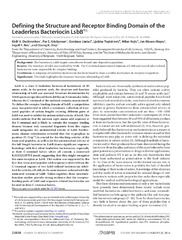Prikaz osnovnih podataka o dokumentu
Defining the Structure and Receptor Binding Domain of the Leaderless Bacteriocin LsbB
| dc.creator | Ovchinnikov, Kirill V. | |
| dc.creator | Kristiansen, Per E. | |
| dc.creator | Uzelac, Gordana | |
| dc.creator | Topisirović, Ljubiša | |
| dc.creator | Kojić, Milan | |
| dc.creator | Nissen-Meyer, Jon | |
| dc.creator | Nes, Ingolf F. | |
| dc.creator | Diep, Dzung B. | |
| dc.date.accessioned | 2022-11-15T14:28:32Z | |
| dc.date.available | 2022-11-15T14:28:32Z | |
| dc.date.issued | 2014 | |
| dc.identifier.issn | 1083-351X | |
| dc.identifier.uri | https://imagine.imgge.bg.ac.rs/handle/123456789/750 | |
| dc.description.abstract | Background: The bacteriocin LsbB targets a membrane-bound zinc-dependent peptidase. Results: The structure of LsbB was resolved by NMR. The C-terminal unstructured domains of LsbB and several other related bacteriocins were responsible for receptor binding. Conclusion: A subgroup of leaderless bacteriocins has been found to share a similar mechanism in receptor recognition. Significance: The study highlights the structure-function relationship of LsbB. LsbB is a class II leaderless lactococcal bacteriocin of 30 amino acids. In the present work, the structure and function relationship of LsbB was assessed. Structure determination by NMR spectroscopy showed that LsbB has an N-terminal -helix, whereas the C-terminal of the molecule remains unstructured. To define the receptor binding domain of LsbB, a competition assay was performed in which a systematic collection of truncated peptides of various lengths covering different parts of LsbB was used to inhibit the antimicrobial activity of LsbB. The results indicate that the outmost eight-amino acid sequence at the C-terminal end is likely to contain the receptor binding domain because only truncated fragments from this region could antagonize the antimicrobial activity of LsbB. Furthermore, alanine substitution revealed that the tryptophan in position 25 (Trp(25)) is crucial for the blocking activity of the truncated peptides, as well as for the antimicrobial activity of the full-length bacteriocin. LsbB shares significant sequence homology with five other leaderless bacteriocins, especially at their C-terminal halves where all contain a conserved KXXXGXXPWE motif, suggesting that they might recognize the same receptor as LsbB. This notion was supported by the fact that truncated peptides with sequences derived from the C-terminal regions of two LsbB-related bacteriocins inhibited the activity of LsbB, in the same manner as found with the truncated version of LsbB. Taken together, these structure-function studies provide strong evidence that the receptor-binding parts of LsbB and sequence-related bacteriocins are located in their C-terminal halves. | en |
| dc.publisher | Amer Soc Biochemistry Molecular Biology Inc, Bethesda | |
| dc.relation | Norwegian University of Life Sciences | |
| dc.relation | Norwegian Centennial Chair program | |
| dc.relation | info:eu-repo/grantAgreement/MESTD/Basic Research (BR or ON)/173019/RS// | |
| dc.rights | openAccess | |
| dc.rights.uri | https://creativecommons.org/licenses/by/4.0/ | |
| dc.source | Journal of Biological Chemistry | |
| dc.subject | Zn-dependent Protease | en |
| dc.subject | Structural Biology | en |
| dc.subject | Receptor | en |
| dc.subject | Peptide Interaction | en |
| dc.subject | Nuclear Magnetic Resonance (NMR) | en |
| dc.subject | Leaderless Bacteriocin | en |
| dc.subject | Bacteriocin Receptor | en |
| dc.subject | Antimicrobial Peptide (AMP) | en |
| dc.title | Defining the Structure and Receptor Binding Domain of the Leaderless Bacteriocin LsbB | en |
| dc.type | article | |
| dc.rights.license | BY | |
| dc.citation.epage | 23845 | |
| dc.citation.issue | 34 | |
| dc.citation.other | 289(34): 23838-23845 | |
| dc.citation.spage | 23838 | |
| dc.citation.volume | 289 | |
| dc.identifier.doi | 10.1074/jbc.M114.579698 | |
| dc.identifier.fulltext | https://imagine.imgge.bg.ac.rs/bitstream/id/671/747.pdf | |
| dc.identifier.pmid | 24993828 | |
| dc.identifier.scopus | 2-s2.0-84906535928 | |
| dc.identifier.wos | 000341505000050 | |
| dc.type.version | publishedVersion |

